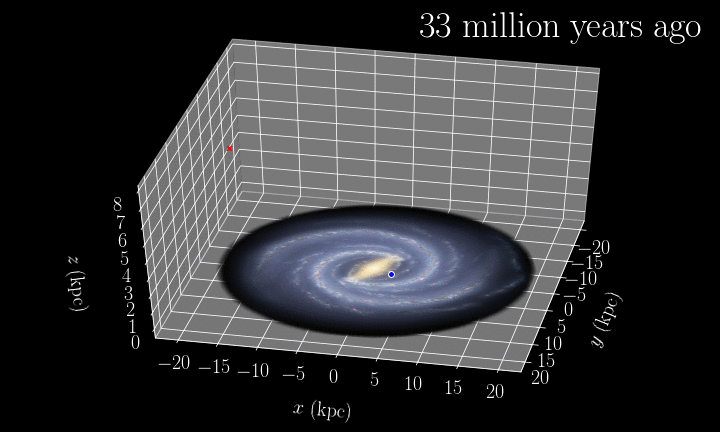Researchers confirm massive hyper-runaway star ejected from the Milky Way Disk

A fast-moving star may have been ejected from the Milky Way's stellar disk by a cluster of young stars, according to researchers from the University of Michigan who say the star did not originate from the middle of the galaxy, as previously believed by astronomers.
"This discovery dramatically changes our view on the origin of fast-moving stars," said Monica Valluri, a research professor in the Department of Astronomy at U-M's College of Literature, Science, and the Arts. "The fact that the trajectory of this massive fast-moving star originates in the disk rather that at the Galactic center indicates that the very extreme environments needed to eject fast-moving stars can arise in places other than around supermassive black holes."
Producing a fast-moving star requires lots of energy, usually found in extreme environments, Valluri said.
The Milky Way contains tens of billions of stars, most of which are distributed in a pizza-like structure called the stellar disk. In 2005, astronomers first discovered fast-moving stars that move more than twice as fast as most other stars—more than 1 million miles per hour, or 500 kilometers per second (310 miles/second), compared to the rest of the galaxy where stars average a bit more than 200 km/sec (124 miles/second).
Less than 30 of these extremely fast-moving stars (generally called "hypervelocity stars") have been discovered so far.
When binary stars—a pair of stars that orbit around each other while moving through a galaxy—pass too close to a black hole, it captures one of the binary stars, and the other one is flung out in a "gravitational slingshot." In order to produce the kinds of velocities astronomers measure for hypervelocity stars, the black hole has to be very massive.
Because there's evidence that there is a supermassive hole at the center of the Milky Way, many astronomers believe that the majority of hypervelocity stars were ejected by this supermassive black hole.
Valluri and U-M postdoctoral researcher Kohei Hattori were interested in tracing the trajectory of LAMOST-HVS1, a massive fast-moving star that's closer to the Sun than any other hypervelocity stars, to pinpoint where in the Milky Way it was ejected. They used one of the Magellan telescopes in Chile to determine the distance and velocity of the star.
Hattori then joined a group of international scientists who congregated in New York last year to participate in a hackathon to download, share and analyze data from the European Space Agency space mission Gaia, a space astrometry mission to make the largest, most precise three-dimensional map of the Milky Way.
Using the current location and current velocity of the star derived from Gaia and Magellan, the astronomers were able to trace back its path, or orbit. To their surprise, it appears the star was ejected from the stellar disk, and not from the center of the Milky Way.
"We thought this star came from the Galactic center. But if you look at its trajectory, it is clear that is not related to the Galactic center, Hattori said. "We have to consider other possibilities for the origin of the star."
The authors theorize that the ejection of this massive star from the stellar disk may be the result of the star experiencing a close encounter with multiple massive stars or an intermediate mass black hole in a star cluster.
Although massive runaway stars that have been ejected from star clusters with speeds of 40-100 km/s (25-62 miles/second) have been known for a long time, none have been observed with the extreme ejection velocity as needed to explain LAMOST-HVS1. Theoretical models for runaway stars that include multiple-massive stars also very rarely produce such extreme velocities, suggesting a more exotic possibility—an intermediate mass black hole.
The computed path of the star originates at a location in the Norma spiral arm that is not associated with previously known massive star clusters. However if this hypothetical star cluster exists, it may be hidden behind the dust in the stellar disk. If it is found, it would provide the first opportunity to directly discover an intermediate mass black hole in the stellar disk of the Milky Way.
Also, the fact that this star may be ejected from a massive cluster in the stellar disk hints at the possibility that many other fast-moving stars may also have been ejected from such star clusters, the researchers say.
Both the Milky Way and Large Magellanic Cloud (a separate small galaxy, orbiting the Milky Way) are known to have some massive star clusters that might be important ejectors of fast-moving stars, contrary to the widely accepted view that they were ejected by interactions with the central black holes in one of these galaxies.
This would also lead to new insights into the interactions of stars and the possible formation of intermediate mass black holes in star clusters, the researchers say.
In addition to Valluri and Hattori, authors included U-M's Guillaume Mahler; Norberto Castro of U-M and the Leibniz Institute for Astrophysics Potsdam, Germany; Ian Roederer of U-M and the Joint Institute for Nuclear Astrophysics-Center for the Evolution of the Elements; and Gourav Khullar of the University of Chicago's Kavli Institute of Cosmological Physics.
Their findings are published in the current issue of Astrophysical Journal.
More information: Kohei Hattori et al. Origin of a Massive Hyper-runaway Subgiant Star LAMOST-HVS1: Implication from Gaia and Follow-up Spectroscopy, The Astrophysical Journal (2019). DOI: 10.3847/1538-4357/ab05c8
Journal information: Astrophysical Journal
Provided by University of Michigan




















